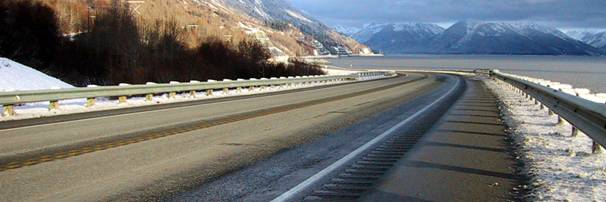Design & Construction Standards
Traffic and Safety Resources
Rumble Strips

Roadway departures account for 54% of all fatal traffic crashes nationwide and about two-thirds of these roadway departures occur in rural areas. Alaska’s statistic is similar. Rumble strips have been shown to be a cost effective safety improvement to reduce the number and severity of run-off-road and lane departure crashes. Rumble strips provide an auditory and tactile warning to errant drivers that they are leaving their lane. Rumbles in Alaska are milled into the finished surface of the road.
Shoulder rumble strips are installed on rural highway just outside the lane edge line. Where bicycles may share the road, shoulder rumble strips are installed with periodic twelve-foot gaps to permit bicyclists a smooth way to cross the strip. Shoulder rumble strips are installed only on highways where the shoulder is in good condition and of adequate width.
Centerline rumble strips may be installed between opposing lanes of traffic on segments of highway with higher than average head-on crashes. Centerline rumbles are continuous throughout the stretch of highway, whether or not passing is permitted. Centerline rumble strips are narrower and shallower than shoulder rumbles to permit intentional crossing, as in passing maneuvers or turning into and out of driveways, without the more aggressive vibration and noise of the shoulder rumble strip.
Frequently Asked Questions
Related Links
- Alaska DOT&PF Rumble Strip Policy

- Federal Highway Administration Rumble Strip web page

- FHWA Rumble Strip Technical Advisory T5040.35 2001

- Alaska Strategic Highway Safety Plan, 2007, Action Plans HR.1 & HH.1

- Excerpts Regarding Rumble Strip Effectiveness in Alaska, from Review of Crash
Reduction Factors for Use in the HSIP, Kinney, 2009

- Alaska Rumble Strip Map with 2001-07 Crashes and 2008 ADTs (March 2010)

Design & Construction Standards
- D&C Standards Home
- Construction
- ePermits
- Preconstruction
- Standard Specifications
- Right-of-Way
- Traffic & Safety
- Publications
- Site Questions & Comments
3132 Channel Dr.,
P.O. Box 112500
Juneau, AK 99811-2500
Phone: (907)451-2283
Pam Golden, P.E.
Statewide Traffic & Safety Engineer
